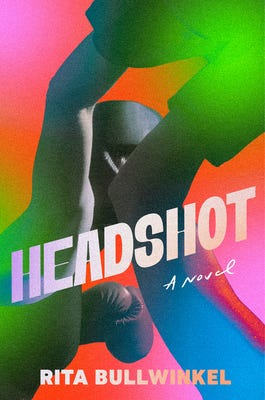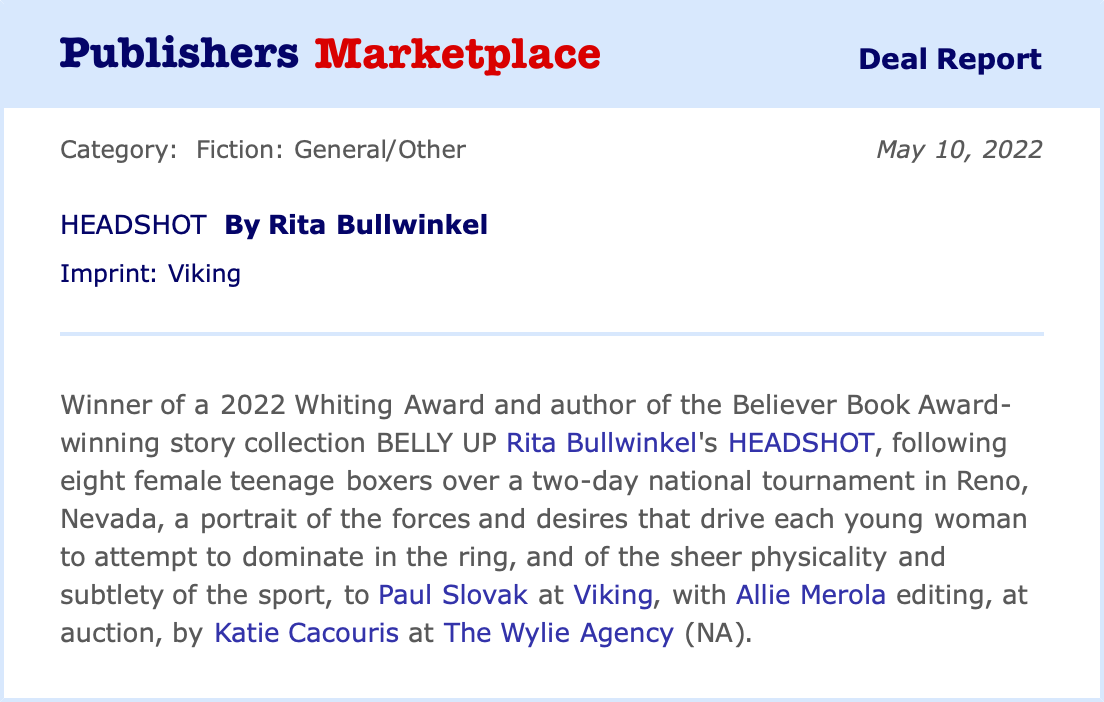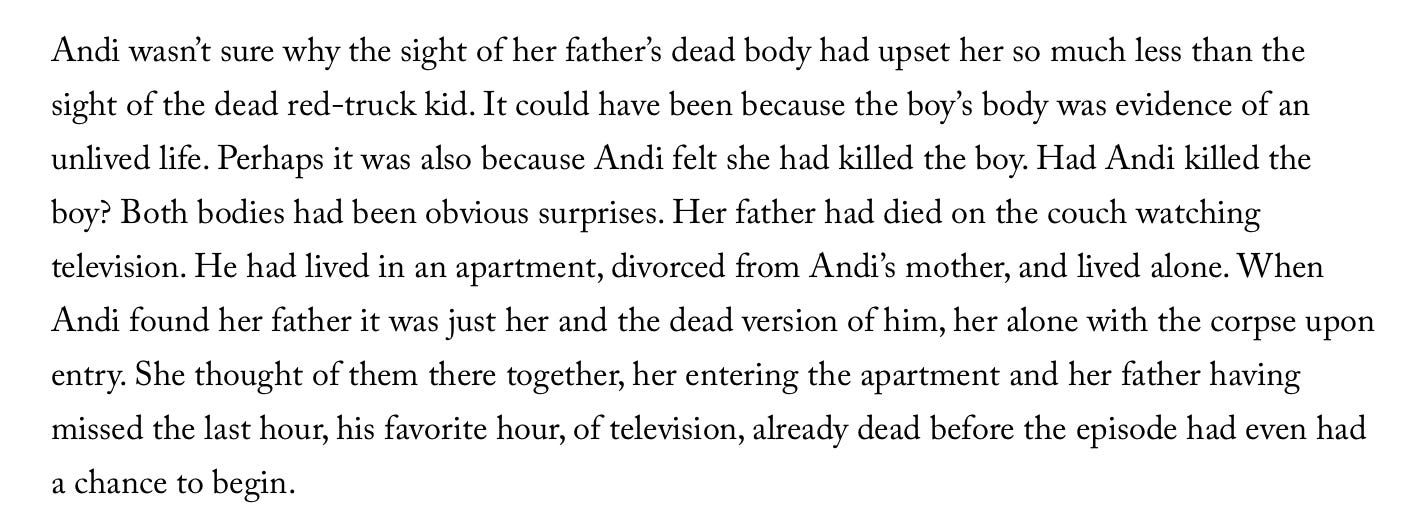THE GIRLS ARE FIGHTING
My opinion behind the sale (to an agent and to the market) of Rita Bullwinkel's debut novel Headshot
There’s a book that’s getting a ton of press right now, Headshot by Rita Bullwinkel, and I want to talk a little bit about why I think it sold, and why, perhaps, it’s so marketable.
Alisha gushed about how smart this event was for the book at City Lights, and I immediately went searching for the book at my library. So, I’ve been reading it off and on for a few weeks—it’s unexpectedly fragmented, here’s an excerpt in Literary Hub purely for vibe purposes.
Let’s get the obvious reasons out of the way:
Her short story collection won the Believer Book Award (she works at Believer and McSweeney’s still), and she also received a 2022 Whiting Award. If I had to think of coveted awards editors and publishers want to see, the Whiting would probably be at the top of my list. And people love to love someone who already has clout.
It’s an easy plot to push—girl boxing. We have the popularity of Fight Club meets the “dark side of girlhood" books boom. (See also: Marlena, Brown Girls, Brutes (which has an ambiguous ending in maybe a bad way?), Girls on Fire, The Most Dangerous Place on Earth (which I loathed) Bunny, The Lightness (which I loved) Conversations with Friends, Luster (which is some of the best contemporary writing)—the girls are behaving “badly.” (Though let’s one day have a conversation about how the girls can be “bad,” but only to a certain extent. They can be violent, but not enjoy violence. What is brutal must be able to come back from the edge. This isn’t Yellowjackets, it’s literature. The brutality must be palatable).
Her agent works at The Wylie Agency (esteemed), but bonus points to Katie Cacouris because I think she’s a new agent (I’m assuming because she only has five deals in Marketplace and she’s a literal ghost on Google), and Headshot sold at auction to Viking.
It is also a book that feels very Viking to me in the same way that Susan Choi’s My Education was a Viking book (early autofiction, funky plot pre-Trust Exercise—as if it was the test book for Trust Exercise, seeing if the market could handle a book like Trust Exercise, which we know it could from the success of Asymmetry a year earlier). I should explain this more probably, but Viking books are either truly ahead of their time or they spend big money on books that feel engage in similar ways thematically or tonally to very successful recent books. So, Bullwinkel’s family tree would be The Virgin Suicides by Jeffrey Eugenides and Brutes by Dizz Tate & then “sports novels”—I like it in conversation with this essay by Lauren van den Berg in Sewanee Review.
The novel has received one streamlined reviewing angle—the viscerality (I made it up) of the bodied language related to the metaphor of boxing, Dwight Gardner of the New York Times saying “fresh and strong and sinuous,” Oprah Daily saying it’s girlhood, “splayed out,” NPR using language like, “hard-punching novel,” Kevin Canfield at San Francisco Chronicle commenting on the metaphor as body (sturdy base too), “excellent footwork — it has a sturdy base yet moves quickly,” The Telegraph with, “skilful prose grips from first to last” (grips), Nylon with, “striking debut,” Bustle with, “refusing to hold back a single, brutal punch,” Cultured Magazine, “holds all these tensions taut for a couple hundred pages” (taut), Electric Literature with “muscular prose,” and Alta not much different, “a muscular, omniscient voice,” and Kirkus too, “muscular language: a ferocious novel . . . unusual and striking,” Publishers Weekly with, “toe-to-toe realism,” Another Magazine, “deft, and tough, but not without grace,” and finally, “insatiable stamina” from KQED.
What I’m seeing and saying here is that reviewers KNEW what the book was. It was pre-defined before it even got to a critic. There are very little differing perspectives on the book in the way it has been received across media—almost like it was pre-packaged, presented as a striking gut punch of unparalleled girls’ ambition and interior lives.
There is (from what I can find right now) not many references to other sports novels or references to the tactical language of the book mentioned in the reviews or publicity, focusing very much instead on girls! doing! violence!
Bullwinkel obviously knows her sport, and yet I also haven’t seen any coverage in sports-adjacent magazines, podcasts, radio. This is probably because inside publicists sometimes don’t have time to do more than the literary scene coverage (hire outside!) but also because book coverage is so minimal (beyond best of year end lists) in magazines that don’t have book sections, or don’t cater to anything like long reads, personal essays, research, audiences who read longer-form work that might shift towards a book-length work.
The reviews being so focused (and maybe one-note) is arguably why a TIGHT elevator pitch, TIGHT synopsis, TIGHT distilled WHAT IS IT is so important to selling a novel at the editorial stage and to market. This novel got so much buzz partly because that was made easy from the first punch. Not all novels are this easy to distill, I get it, but determining what’s at center, what’s the anchor—if we’re looking at a blueprint of the house of your book, what pillar is foundational so that the whole thing continues standing—that’s your query synopsis, that’s your hook, that’s THE thing. (Shout out to Brian Allen Carr’s Bad Foundations for my sudden, architectural knowledge). This is where op-ed advice can come in too, or your fourth grade story analysis worksheets: who, what, when, where, and how—but now do it in a sentence (or a few).
From a craft perspective, I bet Headshot sold on the first five pages (to the agent & to the publisher). Here is the exact part that I think sold the book read by Rita on Debutiful’s First Taste podcast.
It sold (allegedly, in my opinion) with this initial, surprising, repeated image of red-truck shorts. The image lives in the interior experience of one of the first characters in the book, Andi. While she’s on lifeguard duty, a four year old drowns and she pulls him from the pool in his red truck shorts. All of her interior monologues return to this image, the child’s thigh, his red-truck shorts, and her unnamed (unarmed?) shame. The metaphor of blocking is apt for her, but she’s loose and goose in comparison to her opponent, Artemis Victor (pun intended, right?). Andi is the underdog in a sport of “bottom dogs.” She’s less-trained, less-formal, more-scrappy, more-wild. And she’s alone, miles from home, subsidizing her life in the face of her own loneliness.
This image and Andi’s emotional terrain related to it, I think, sold the book. At least when I was a literary agent, those first five pages would have made me request the full book. It’s such an immediate, emotionally reactive moment, and that image leaves hooks in a reader. So, after that initial opening, an agent would be reading towards a yes, rather than towards a no. To make more sense of this, an agent wouldn’t be looking for a reason to turn down the full manuscript at the querying stage, but instead looking to confirm what she already felt from those initial pages.
Here’s a piece of the book with that image repeated from the Literary Hub excerpt:
It also helps from a craft standpoint that this book has no lines of dialogue, it’s all interior monologue. You could also argue that potentially the whole book is dialogue. Both are an intriguing selling point to classrooms and BFA/MFA programs. It already lends itself to study, the way Trust Exercise was immediately adoptable.
Join us! https://www.crowdcast.io/c/womenwholeaveapril2024
As always, the Pine State calendar of events lives here, and you can buy our books here! You can also see what we’re working on and contact us through our website, Pinestatepublicity.com.
ICYMI: Jessica Jacobs talks access with ancient texts in The Rumpus and interviewed in WHMP, and featured in new books by New England Review authors, Rosanna Oh’s The Corrected Version is reviewed in Rhino, Margo Steines is on Mental Illness Happy Hour & Mama is Lit, and Hotter Than Ever, Iris Jamahl Dunkle is on the History of Literature podcast, Sara Johnson Allen’s Down Here We Come Up is reviewed in Reckon Review, Jenny Irish’s HATCH is enthusiasm’ed on Arizona Poetry Center blog, and so much more on our Twitter & Instagram.












I cannot wait to read this book. And if there were 8 days in a week and today was the extra one, I would immediately start reading every title you referenced here. Oh, sigh. Time. Thx for this!